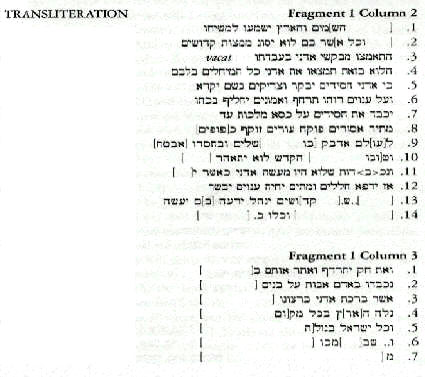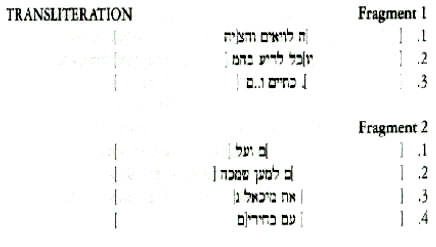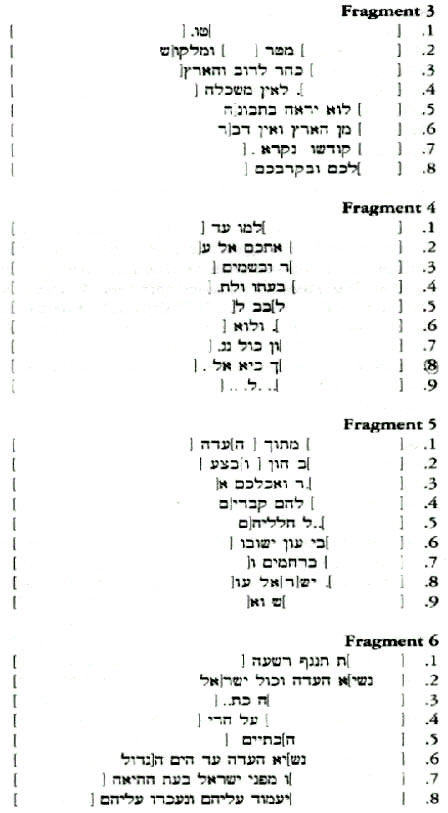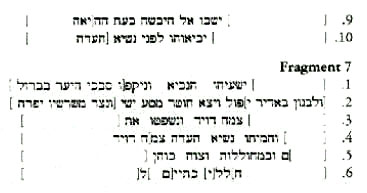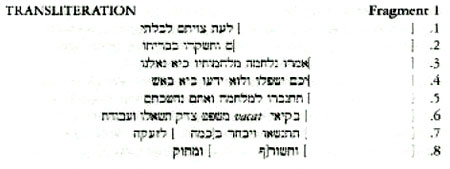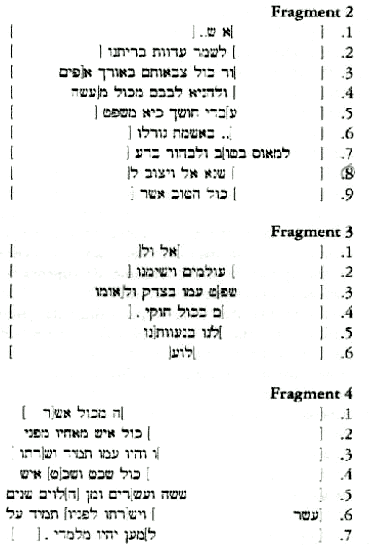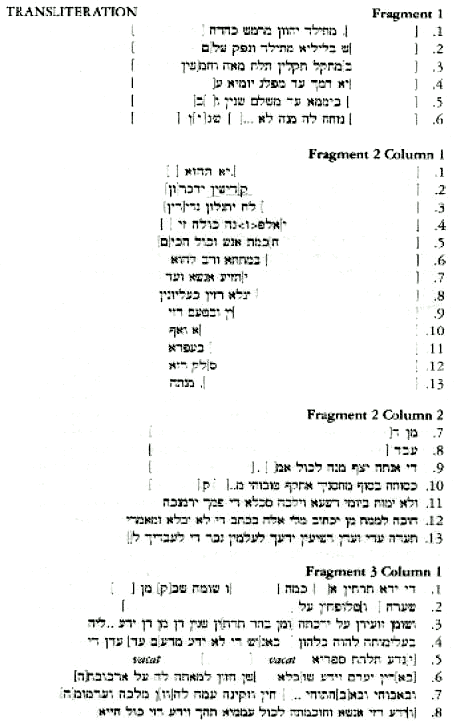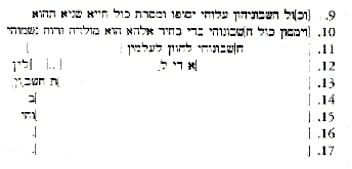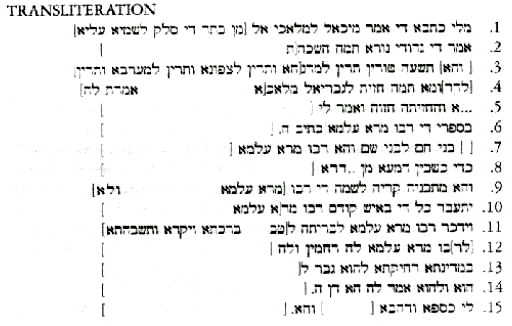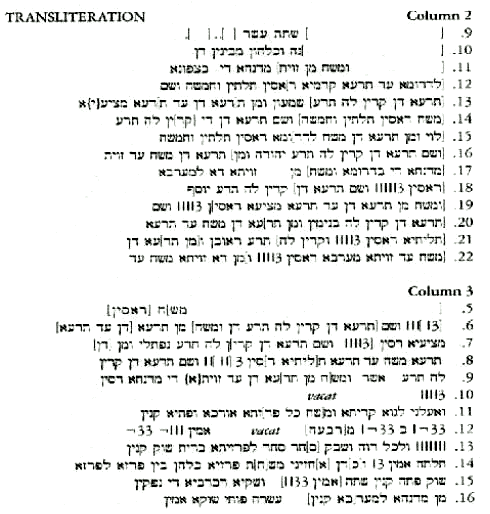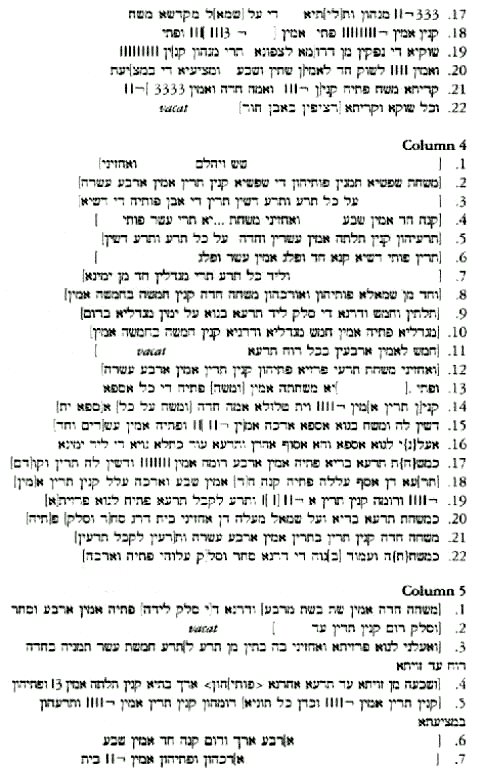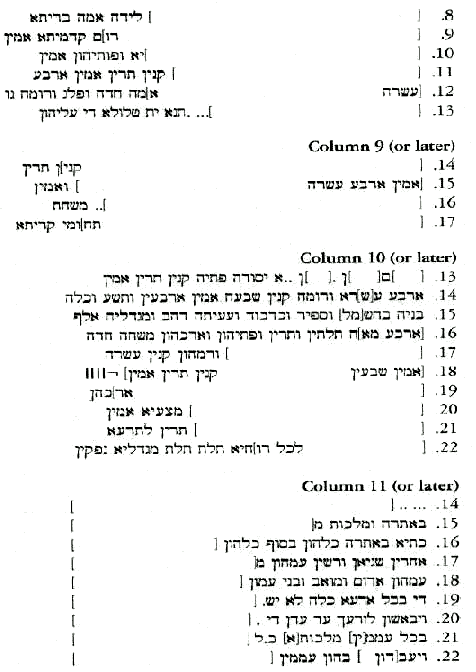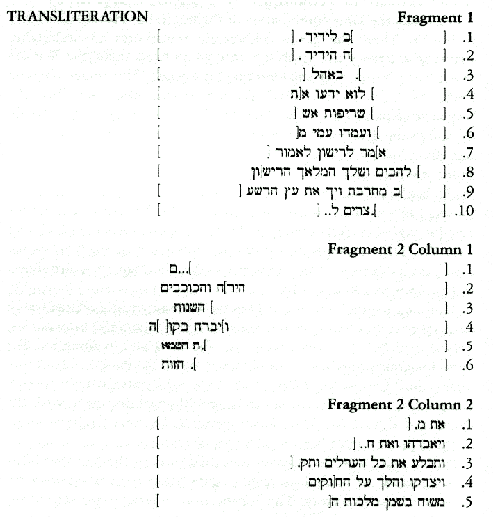Chapter 1 - Messianic and Visionary Recitals
These texts constitute some of the most thought-provoking in the corpus. We have
placed them in the first Chapter because of the importance of their Messianic,
visionary and mystical - even Kabbalistic - content and imagery. These are not
the only texts with such import. This kind of thrust will grow to a climax in
Chapters 5 and 7.
But the Messianic theorizing these texts exhibit is particularly interesting -
it has heretofore either been underestimated or for some reason played down in
the study of the Scrolls. In at least two texts in this Chapter (not to mention
other Chapters), we have definite Messianic allusions: the Messianic vision text
we call, after an allusion in its first line, the Messiah of Heaven and Earth,
and the Messianic Leader (Nasi) text. In both there are clear correspondences to
recognized Messianic sections in the Prophet Isaiah.
Interestingly, we do not have the two-Messiah doctrine highlighted in a few of
the texts from the early days of Qumran research, like the Damascus Document
found in two recensions at the end of the last century in the Cairo Genizah or
the Community Rule from Cave 1, but rather the more normative, single Messiah
most Jews and Christians would find familiar. Though in the Messianic Leader (Nasi)
text, this figure is nowhere declared to be a ‘Messiah’ as such, only a
Messianic or eschatological ‘Leader’, the Messianic thrust of the Biblical
allusions underpinning it and the events it recounts clearly carry something of
this signification.
Its relation to the Damascus Document, further discussed in
our analysis of the Messianic Florilegium in Chapter 4, do as well. But even in
the published corpus, there is a wide swath of materials, particularly in the
Biblical commentaries (the pesharim) on Isaiah, Zechariah, Psalms, etc., and
compendiums of Messianic proof texts, that relate to a single, more nationalist,
Davidic-style Messiah, as opposed to a second with more priestly characteristics
that has been hypothesized. This last is, of course, in evidence too in the
Letter to the Hebrews, where the more eschatological and high-priestly
implications of Messiah-ship are expounded.
Even in the Damascus Document, there is some indication in the first column of
the Cairo recension that the Messianic ‘Root of Planting out of Aaron and
Israel’ has already come. The ‘arising’ or ‘standing up’ predicted in the later
sections can be looked upon, as well, as something in the nature of a Messianic
‘return’ - even ‘resurrection’ (see Dan. 12:13 and Lam R ii-3.6 using ‘amod or
‘standing up’ in precisely this vein and our discussion of the Admonitions to
the Sons of Dawn below).
Nor is it completely clear in the Cairo Damascus
Document that the allusion to ‘Aaron and Israel’ implies dual Messiahs, and not
a single Messiah out of two genealogical stalks, which was suggested by scholars
in the early days of research on it, and is, as we shall see, the more likely
reading.
The very strong Messianic thrust of many of the materials associated with Qumran
has been largely
overlooked by commentators, in particular the presence in the published corpus
in three different
places of the ‘World Ruler’ or ‘Star’ prophecy from Num. 2 4:17 - that ‘a Star
would rise out of Jacob, a
Sceptre to rule’ the world - i.e. in the Damascus Document, the War Scroll, and
one of the
compendiums of Messianic proof texts known as a Florilegium. There can be little
doubt that the rise
of Christianity is predicated on this prophecy. Our own Genesis Florilegium,
playing on this title, also
ends up with an exposition of another famous Messianic prophecy - the ‘Shiloh’
from Gen. 49:10, which also includes the ‘sceptre’ aspect of the above prophecy.
The first-century Jewish historian Josephus, an eye-witness to the events he
describes, identifies the world ruler prophecy as the moving force behind the
Jewish revolt against Rome in AD 66-70 (War 6.317). Roman writers dependent on
him, like Suetonius (Twelve Caesars 10.4) and Tacitus (The Histories 2.7 8 and
5.13) do likewise. Rabbinic sources verify its currency in the events
surrounding the fall of the Temple in AD 7 0 (ARN 4 and b. Git 56b).
However,
reversing its thrust, these last present their hero, the Rabbi Yohanan b.
Zacchai as applying it - as Josephus himself does - to the destroyer of
Jerusalem and future Roman Emperor Vespasian! The Bar Kochba uprising in AD
132-6 can also bethought of as being inspired by this prophecy, as Bar Kosiba’s
original name seems to have been deliberately transmuted into one incorporating
this allusion, i.e. Bar Kochba - ‘Son of the Star’.
The other texts in this
section are all visionary and eschatological, most often relating to Ezekiel,
the original visionary and eschatological prophet and a favourite in Qumran
texts. Whatever else can be said of them, their nationalist, militant,
apocalyptic and unbending thrust cannot be gainsaid, nor should it be
overlooked.
Back to Contents
1. The Messiah Of Heaven And Earth (4Q521) (Plate 1)
This text is one of the most beautiful and significant in the Qumran corpus. In
it many interesting themes that appear in other Qumran texts reappear. In the
first place, there is continued emphasis on ‘the Righteous’ (Zaddikim), ‘the
Pious’ (Hassidim), ‘the Meek’ (‘Anavim), and ‘the Faithful’ (Emunim). These
terms recur throughout this corpus (in particular see the Hymns of the Poor
below) and should be noted as more or less interchangeable allusions and
literary self-designations.
The first two are important in the vocabulary of
Jewish mysticism; the last two in that of Christianity. New themes also appear,
such as God’s ‘Spirit hovering over the Meek’ and ‘announcing glad tidings to
the Meek’, themes with clear New Testament parallels. These also include the
Pious being ‘glorified on the Throne of the Eternal Kingdom’, which resonates as
well with similar themes in the New Testament and the Kabbalah, and God
‘visiting the Pious’ and ‘calling the Righteous by name’, both paralleled in the
Damascus Document. In CD, i.7 God is said to have ‘visited’ the earth causing,
as we have seen, a Messianic ‘Root of Planting’ to grow, and following this, in
iv.4, ‘the sons of Zadok’ are described as being ‘called by name’.
This phrase
‘called by name’ is also found in column ii. II of the Damascus Document, where
it is followed by the statement that God ‘made His Holy Spirit known to them by
the hand of His Messiah’- words which resonate with the language of the present
text as well.
Not only do parallel allusions confirm the relationship of the
‘sons of Zadok’ with the ‘Zaddikim’ (‘the Righteous’/’Righteous Ones’), but
‘naming’ and predestination are important themes in both the early columns of CD
and Chapters 2 - 5 of Acts, where, for instance, the predestination of Christ
and the language of the Holy Spirit are signaled. If the additional fragments of
this text - which may or may not be integral to it - are taken into
consideration, then there is some allusion to ‘anointed ones’ or ‘messiahs’
plural, probably referring to the priests doing service in the Temple.
The two
columns of the major fragment on this plate (no. 1) very definitely, however,
evoke a singular, nationalist Messiah, as does the interpretation of the ‘Shiloh
Prophecy’ related to it in the Genesis Florilegium below.
He is to a certain extent a supernatural figure in the manner of Dan. 7’s ‘Son
of Man coming on the clouds of Heaven’. This imagery is recapitulated in Column
xif. of the War Scroll from Cave 1 at Qumran, which interprets the ‘Star
Prophecy’ in terms of it and the rising of ‘the Meek’ in some final apocalyptic
war. The War Scroll, of course, also uses eschatological ‘rain’ imagery to
identify these ‘clouds’ with the ‘Holy Ones’ (‘the Kedoshim’ or ‘Heavenly
Host’).
In the Messiah of Heaven and Earth text, not only are the ‘heavens and
the earth’ subsumed under the command of the Messiah, but so, too, are these
presumed ‘Kedoshim’ or ‘Holy Ones’ from the War Scroll. There are also the very
interesting allusions to ‘My Lord’ / Adonai, referred to in Isa. 6 1:1, which
seems to underlie much of the present text; but since the sense of this is often
so imprecise, it is impossible to tell whether the reference is to God or to
‘His Messiah’ whom it so celebrates.
If the latter, this would bring its imagery
closer still to similar New Testament recitations. The reader should note,
however, that for Josephus mentioned above, one of the determining
characteristics of those he calls Essenes and Zealots was that they would not
‘call any man Lord’ (italics ours). By far the most important lines in Fragment
1 Column 1 are Lines 6-8 and 11- 13, referring to ‘releasing the captives’,
‘making the blind see’, ‘raising up the downtrodden’, and ‘resurrecting the
dead’. The last allusion is not to be doubted. The only question will be, who is
doing this raising, etc. - God or ‘His Messiah’? In Lines 6-8 the reference
seems to be to God. But in Lines 11- 13, it is possible that a shift occurs, and
the reference could be to ‘His Messiah’. The editors were unable to agree on the
reconstruction here.
In any event, language from Isa. 6 1:1 (see above) is also clearly identifiable
in both line 8 and line 11. But likewise, there are word for-word
correspondences to the Eighteen Benedictions, among the earliest strata of
Jewish liturgy and still a part of it today: ‘You will resurrect the dead,
uphold the fallen, heal the sick, release the captives, keeping faith with those
asleep in the dust...’, referring obviously to God.
It should be noted too that
these portions include reference to the Hassidim, also evoked several times in
the present text. It is also interesting to note that Isa. 60:2 1, which
precedes Isa. 61:1, contains the ‘Root of Planting’ imagery used in the first
column of the Damascus Document referred to above and the ‘Branch’ imagery that
will be so prominent in the Messianic Leader (Nasi) text that follows below.
The reference to ‘raising the dead’ solves another knotty problem that much
exercised Qumran commentators, namely whether those responsible for these
documents held a belief in the resurrection of the dead. Though there are
numerous references to ‘Glory’ and splendid imagery relating to Radiance and
Light pervading the Heavenly abode in many texts, this is the first definitive
reference to resurrection in the corpus. It should not come as a surprise, as
the belief seems to have been a fixture of the Maccabean Uprising as reflected
in 2 Macc. 12:44-45 and Dan. 12:2, growing in strength as it came down to
first-century groups claiming descent from these archetypical events.
Translation
Fragment 1
Column 2 (1)[... The Hea]vens and the earth will obey His Messiah,
(2) [... and all th]at is in them. He will not turn aside from the Commandments
of the Holy Ones. (3) Take strength in His service, (you) who seek the Lord. (4)
Shall you not find the Lord in this, all you who wait patiently in your hearts?
(5) For the Lord will visit the Pious Ones (Hassidim) and the Righteous (Zaddikim)
will He call by name. (6) Over the Meek will His Spirit hover, and the Faithful
will He restore by His power. (7) He shall glorify the Pious Ones (Hassidim) on
the Throne of the Eternal Kingdom. (8) He shall release the captives, make the
blind see, raise up the do[wntrodden.] (9) For[ev]er will I cling [to Him ...],
and [I will trust] in His Piety (Hesed, also ‘Grace’), (10) and [His] Goo[dness...] of Holiness will not delay ...(11) And as for the wonders that are not
the work of the Lord, when He ... (12) then He will heal the sick, resurrect the
dead, and to the Meek announce glad tidings. (13)... He will lead the [Holly
Ones; He will shepherd [th]em; He will do (14)...and all of it... Fragment l
Column 3 (1) and the Law will be pursued. I will free them ... (2) Among men the
fathers are honored above the sons ...(3)I will sing (?)the blessing of the Lord
with his favor...(4) The 1[an]d went into exile (possibly, ‘rejoiced) every-wh[ere...] (5) And all Israel in exil[e (possibly ‘rejoicing’) ...] (6) ... (7) ...
Fragment 2
(1) ... their inheritan[ce...] (2) from him ...
Fragment 3 Column 1 (4) ... he will not serve these people (5) ... strength ()
... they will be great Fragment 3 Column 2 (1) And... (3) And ... (5) And ...
(6) And which ... (7) They gathered the noble[s...] (8) And the eastern parts of
the heavens ... (9) [And] to all yo[ur] fathers ... Fragment 4 (5) ... they will
shine (6)... a man (7) ... Jacob (8)... and all of His Holy implements (9)...
and all her anointed ones (10)... the Lord will speak... (11) the Lord in
[his] might (12)... the eyes of Fragment 5 (1)... they [will] see all... (2) and everything in it... (3) and all the fountains of water, and the
canals... (4) and those who make... for the sons of Ad[am...] (5) among
these curs[ed ones.] And what ...(6) the soothsayers of my people ... (7) for
you ... the Lord ... (8) and He opened...
Back to Contents
2. The Messianic Leader (NASI - 4Q285) (Plate 2)
We released this text at the height of the controversy over access to the Dead
Sea Scrolls in November
1991. Since then much discussion has occurred concerning it. Our purpose in
releasing it was to show that there were very interesting materials in the
unpublished corpus which for some reason had not been made public and to show
how close the scriptural contexts in which the movement or community responsible
for this text and early Christianity were operating really were. However one
reconstructs or translates this text, it is potentially very explosive.
As it
has been reconstructed here, it is part of a series of fragments. There is no
necessary order to these fragments, nor in that of other similar materials
reconstructed in this book. Such materials are grouped together on the basis
either of content or handwriting or both, and the criterion most often employed
is what seemed the most reasonable.
Here, the key question is whether Fragment 7 comes before or after Fragment 6.
If after, as we have placed it in our reconstruction, then the Messianic Nasi or
‘Leader’ would be alive after the events described in Fragment 6 and could he
the one ‘put to death’. This was our initial assessment. If before, then it is
possible that the Messianic Leader does the ‘putting to death’ mentioned in the
text, though such a conclusion flies in the face of the logic of the appositives
like ‘the Branch of David...’ grouped after the expression ‘the Nasi ha—‘Edah’,
which would be clumsy even in Hebrew.
Another question that will arise
concerning this text is whether the individual who appears to be brought before
‘the Leader of the Community’ in Fragment 6 is the same as the one referred to
in Fragment 7 by the pronoun ‘him’, if in fact a him’ can be read into this line
at all and not simply the plural of the verb, ‘kill/killed’. In Hebrew the
spelling is the same. The reader should keep in mind that whether there is any
real sequentiality in these fragments or whether they even go together at all is
conjectural, and these questions will probably not be resolved on the basis of
the data before us.
In favour of the Nasi ha—‘Edah being killed - which, all
things being equal, makes most sense if Fragment 7 is considered by itself only
- even without the accusative indicator in Biblical Hebrew, ‘et’ there are many
texts at Qumran and from the Second Temple period generally that are not careful
about the inclusion of the object indicator in their Hebrew, including the
Messiah of Heaven and Earth above and the Eighteen Benedictions mentioned above.
Another counter example where the object indicator is not employed occurs m
Column ü.12 of the Damascus Document, where reference is made to ‘His Messiah
making known the Holy Spirit’, also mentioned above. Concerning whether our
reconstruction of Line 4 of Fragment 7 attaching ‘the Branch of David’ to ‘the
Leader of the Community’ is correct, it is interesting to note that not only is
‘the Prophet Isaiah’ mentioned in Line 1, but Line 2 quotes 11:1: ‘A staff shall
rise from the stem of Jesse and a shoot shall grow from his roots.’ There even
seems to be an allusion to its second line, ‘the Spirit of the Lord shall rest
upon Him’, in Line 6 of the Messiah of Heaven and Earth above, and we will see
this same passage actually evoked at the end of the beautiful Chariots of Glory
text in Chapter 7 below.
This prophecy was obviously a favourite proof text at
Qumran, as it very definitely was in early Christianity. But this prophecy has
already been subjected to exegesis in the already-published Isaiah Commentary
{a} from Cave 4. There are many such overlaps in Qumran exegeses, including that
of the ‘Star Prophecy’ already noted.
In 4QpIs{a}, the exegesis of Isa. 11:1- 3 is preceded by one of Isa. 10:33-4
about ‘Lebanon being
felled by a Mighty One’ amid allusions to ‘the warriors of the Kittim’ and
‘Gentiles’. This seems to be the case in the Messianic Leader (Nasi) text as
well, where allusions to ‘the Kittim’ in other fragments - including ‘the slain
of the Kittim’ abound, showing the context of the two exegeses to have been more
or less parallel.
These kinds of texts about ‘the falling of the cedars of
Lebanon’ or ‘Lebanon being felled by a Mighty One’, as it is expressed in both
texts, usually bear on the fall of the Temple or the priesthood. In Rabbinic
literature, Isa. 10:3 3 -4 is interpreted in this way, and specifically and one
might add definitively - tied to the fall of the Temple in AD 70 (see ARN 4 and
b. Girt 56ª). Sometimes ‘Lebanon’ imagery, which like ‘Kittim’ is used across
the board in Qumran literature, relates especially when the imagery is positive,
to the Community leadership.
The reference is to the ‘whitening’ imagery
implicit in the Hebrew root ‘Lebanon’. This is played upon to produce the
exegesis, either to Temple, because the priests wore white linen there or to the
Community Council, presumably because its members also appear to have worn white
linen. Readers familiar with the New Testament will recognize ‘Community’ and
‘Temple’ here as basically parallel allusions, because just as Jesus is
represented as ‘the Temple’ in the Gospels and in Paul, the Community Rule,
using parallel spiritualized ‘Temple’ imagery in viii. 5 -6 and ix.6, pictures
the Qumran Community Council as a ‘Holy of Holies for Aaron and a Temple for
Israel’. This imagery, as we shall see, is widespread at Qumran, including
parallel allusions to ‘atonement’, ‘pleasing fragrance’, ‘Cornerstone’, and
‘Foundation’ which go with it.
Completing the basic commonality in these texts, 4QpIs{a} also sympathetically
evokes ‘the Meek’ and goes on to relate Isaiah 11:1’s ‘Staff’ or ‘Branch’ to the
‘Branch of David’ in Jeremiah and Zechariah. Highlighting these Messianic and
eschatological implications, it describes the Davidic ‘Branch’ as ‘standing at
the end of days’ (note the language of ‘standing’ again). In the process, it
incorporates ‘the Sceptre’ language from the ‘Star Prophecy’, which will also
reappear, as we shall see, in the Shiloh Prophecy in the Genesis Florilegium
below. The ‘Star Prophecy’, too, as the reader will recall, was quoted in a
passage in the War Scroll with particular reference to ‘the Meek’. The War
Scroll too makes continual reference to ‘Gentiles’ and ‘Kittim’.
To complete the circularity, 4Qpls{a} ends with an evocation of ‘the Throne of
Glory’, again mentioned in the Messiah of Heaven and Earth text above and
alluded to in jet. 33:18 - which in turn also evokes ‘the Branch of David’ again
and other texts below like the Hymns of the Poor and the Mystery of Existence.
We are clearly in a wide-ranging universe here of interchangeable metaphors and
allusions from Biblical scripture.
The reference to ‘woundings’ or pollution’s in Line 5 of Fragment 7 of the
present text and the total ambiance of reference to Messianic prophecy from
Isaiah, Jeremiah, Zechariah, etc. heightens the impression that a Messianic
‘execution’ of some kind is being referred to. This is also the case in Isa.
11:4 where the Messianic Branch uses ‘the Sceptre of his mouth ... to put to
death the wicked’, however this is to be interpreted in this context.
The reader should appreciate that the Nasi ha-‘Edah does not necessarily
represent a Messiah per se,
though he is being discussed in this text in terms of Messianic proof texts and
allusions. ‘Nasi’ is a
term used also in Column v. l of the Damascus Document when alluding to the
successors of David. In
fact, the term ‘Nasi ha—‘Edah’ itself actually appears in CD’s critical
interpretation of the ‘Star
Prophecy’ in Column vii, which follows. In its exegesis CD ties it to ‘the
Sceptre’ as we shall see in
Chapter 3 below.
Not only is it used in Talmudic literature to represent scions
of the family of David, but coins from the Bar Kochba period also use it to
designate their hero, i.e. ‘Nasi Israel’ ‘Leader of Israel’. Today the term is
used to designate the President of the Jewish State. This reference to meholalot
(woundings) in Line 5 of Fragment 7, followed by an allusion to ha-cohen (the
priest) - sometimes meaning the high priest - would appear to refer to an
allusion from Isa. 5 3:5 related to the famous description there of the
‘Suffering Servant’, so important for early Christian exegetes, i.e. ‘for our
sins was he wounded’ or ‘pierced’.
Though it is possible to read meholalot in
different ways, the idea that we have in this passage an allusion to the
‘suffering death’ of a Messianic figure does not necessarily follow, especially
when one takes Isa. 11:4 into consideration. Everyone would have been familiar
with the ‘Suffering Servant’ passages in Isaiah, but not everyone would have
used them to imply a doctrine of the suffering death of a Messiah.
In fact, it
is our view that the progenitors of the Qumran approach were more militant,
aggressive, nationalistic and warlike than to have entertained a concept such as
this in anything more than a passing manner. It has also been argued that this
Messianic Nasi text should be attached to the War Scroll. This would further
bear out the point about violent militancy, because there is no more warlike,
xenophobic, apocalyptic and vengeful document - despite attempts to treat it
allegorically - in the entire Qumran corpus than the War Scroll.
There can be no mistaking this thrust in the present document, nor the parallel
4QpIs{a}. Its nationalistic thrust should be clear, as should its Messianism. If
these fragments do relate to the War Scroll, then they simply reinforce the
Messianic passages of the last named document. The ‘Kittim’ in the War Scroll
have been interpreted by most people to refer to the Romans. The references to
Michael and the ‘Kittim’ in the additional fragments grouped with the present
text simply reinforce these connections, increasing the sense of the Messianic
nationalism of the Herodian period. However these things may be, the
significance of all these allusions coming together in a little fragment such as
this cannot be underestimated.
Translation
Fragment 1
(1) ... the Levites, and ha[lf...] (2) [the ra]m’s horn, to blow on
them ... (2) the Kittim, and
...
Fragment 2
(1)... and against ...(2) for the sake of Your Name ... (3) Michael
...(4) with the Elec[t...] Fragment 3 (2)...rain ...and spring [rain ...] (3) as
great as a mountain. And the earth ... (4) to those without sense ... (5) he
will not gaze with Understand[ing ...] (6)from the earth. And noth[ing ...] (7)
His Holiness. It will be called ... (8) your...and in your midst...
Fragment 4
(1) ... until ... (2) you to (or ‘God’)...(3)and in Heaven ...(4) in
its time, and to...(5)[he]art, to...(6)and not... (7) all... (8) for God...
Fragment 5
(1) ...from the midst of[the]community ...(2) Riches [and] booty .. .
(3) and your food . ..
(4) for them, grave[s . ..] (5) the[ir] slain... (6) of iniquity will return... (7) in compassion and...
(8) Is[r]ael...
Fragment 6
(1)... Wickedness will be smitten ...(2) [the Lea]der of the
Community and all Isra[el...] (4) upon the mountains of... (5) [the]
Kittim... (<) [the Lea]der of the Community as far as the [Great] Sea...
(7) before Israel in that time . .. (8) he will stand against them, and they
will muster against them ...(9) they will return to the dry land in th[at] time
...(10) they will bring him before the Leader of [the Community ...]
Fragment 7
(1) ... Isaiah the Prophet, [’The thickets of the forest] will be fell[ed with
an axe] (2) [and Lebanon shall f]all [by a mighty one.] A staff shall rise from
the root of Jesse, [and a Planting from his roots will bear fruit.’] (3)...
the Branch of David. They will enter into judgement with ...(4) and they will
put to death the Leader of the Community, the Bran[ch of David] (this might also
be read, depending on the context, ‘and the Leader of the Community, the Bran[ch
of David’], will put him to death) ... (5) and with woundings, and the (high)
priest will command ... (G)
[the sl]ai[n of the] Kitti[m]...
Back to Contents
3. The Servants Of Darkness (4Q471)
This is a text of extreme significance and another one related to the War
Scroll. The violence, xenophobia, passionate nationalism and concern for
Righteousness and the Judgements of God are evident throughout. Though these may
have a metaphoric meaning as well as an actual one, it is impossible to think
that those writing these texts were not steeped in the ethos of a militant army
of God, and hardly that of a peaceful, retiring community. Their spirit is
unbending, uncompromising. They give no quarter and expect none.
There is the particularly noteworthy stress on ‘Lying’, a theme one finds across
the spectrum of Qumran literature, in particular where the opponents of the
community or movement responsible for these writings are concerned. There is
also the actual use of the verb ma’as (meaning to ‘reject’ or ‘deny’) in
Fragment 2.7, paralleling similar usages in the Community Rule, the Habakkuk
Pesher, etc.
In texts such as these, ma~as is always used to portray the
activities of the ideological adversary of the Righteous Teacher, the ‘Liar’/
‘Spouter’ who ‘rejects the Law in the midst of the whole congregation’ or the
parallel activities of those archetypical ‘sons/servants of Darkness’ who do
likewise. Here it is used in contradistinction to ‘choosing’ in this case the
groups’ opponents reverse the natural order; they ‘choose the Evil’, instead of
‘the Good’, which they ‘reject’.
Similar reversals occur across the board in Qumran literature - one particularly
noteworthy one in Column i of the Damascus Document, where ‘justifying the
Wicked and condemning the Righteous’ on the part of ‘the Breakers’ of both ‘Law
and Covenant’ is juxtaposed in Column iv with the proper order noted below of
‘justifying the Righteous and condemning the Wicked’. This last is definitive of
‘the sons of Zadok’, itself synonymous probably too with ‘the Zaddikim’ in Line
5 of the Messiah of Heaven and Earth text. Both texts use the same reference,
‘called by name’, as descriptive of these respective terminologies.
There is the usual emphasis on fire, presumably the judgements of Hellfire, and
there is no shirking the duty for war, which is to be seen in some sense, if
Fragment 4 is taken into account, as being fought under levitical or priestly
command (cf. War Scroll ii. l- 3). There is the usual emphasis on ‘works’
(Fragment 2, Column 4 reconstructed) and particularly noteworthy is the
reference to ‘Servants of Darkness’ as opposed presumably to ‘Servants of
Light’.
The Jamesian parallels to the theme of ‘works’ should be clear; so too should
Paul’s characterization in 2 Cor. 11-12 of the Hebrew ‘archapostles’ -
presumably including James - as disguising themselves as ‘Servants of
Righteousness’ (cf. the actual use of this allusion in the Testaments of
Naphtali below) and ‘apostles of Christ’, when in fact they are ‘dishonest
workmen and counterfeit apostles’.
Paul also employs ‘Light’ terminology in this
passage, not to mention an allusion to ‘Satan’ so important in referring to Mastemoth /Mastema and its parallels below, i.e. ‘even Satan disguises himself
as an Angel of Light.’ Emphasizing ‘Truth’ (the opposite, it will be noted, of
‘Lying’) and at the same time parodying the position of everyman according to
his works, in 11:31 he revealingly insists, ‘he does not lie’, thus
demonstrating his awareness of the currency of these kinds of accusations at
this time.
His application of such ‘Lying’ terminology so widespread in these Qumran
documents - to himself, even if inadvertently, is noteworthy indeed.
One should also note, in particular, the widespread vocabulary of ‘Judgement’,
the ‘Heavenly Hosts’ and even ‘pollution’. Notice, too, the consistent emphasis
on ‘Righteousness’ and ‘Righteous judgement’, and on ‘keeping’, i.e. ‘keeping
the Law’ - ‘Covenant’ in this text. The group responsible for these writings is
extremely Law oriented and their zeal in this regard is unbending. The very use
of the word ‘zeal’ connects the literature with the Zealot mentality and
movement.
The terms ‘keeping’ and ‘Keepers of the Covenant’ also relate to the
second definition in Column 4 of the Community Rule of ‘the sons of Zadok’, a
term with probable esoteric parallels and variations in ‘sons of Righteousness’,
as we have seen above. One should also note the use of the word ‘reckoned’ in
Line 5 of Fragment 1, which resonates with the use of this term in the key
Letters on Works Righteousness below in Chapter 6.
Translation
Fragment 1
(1) ... the time You have commanded them not to (2) ... and you shall
lie about His Covenant (3) ... they say, ‘Let us fight His wars, for we have
polluted (4)... your [enemie]s shall be brought low, and they shall not know
that by fire (5)... gather courage for war, and you shall be reckoned (6)... you
shall ask of the experts of Righteous judgement and the service of (7)... you
shall be lifted up, for He chose [you]... for shouting (8) ... and you shall
bur[n...]and sweet...
Fragment 2
(2) to keep the testimonies of our Covenant
...(3) all their hosts in forbear[ante...] (4) and to restrain their heart
from every w[ork ...(5) Se]wants of Darkness, because the judgement ...(6) in
the guilt of his lot... (7) [to reject the Go]od and to choose the Evil...
(8) God hates and He will erect ...
(9) all the Good that...
Fragment 3
(2) Eternal, and He will set us ...(3)[He jud]ges His people in
Righteousness and [His] na[tion in ...] (4) in all the Laws of ...(5) us in
[our]sins...
Fragment 4
(1) from all tha[t...] (2) every man from his brother, because (3)
... and they shall remain with Him always and shall se[rvel (4) ... each and
every tribe, a man (5) . . [twen]ty-[six] and from [the] Levites six(6) [teen...] and [they] shall se[rve before Him] always upon (7)... [in] order that
they may be instructed in ...
Back to Contents
4. The Birth Of Noah (4Q534-536)
A pseudepigraphic text with visionary and mystical import, the several fragments
of this text give us a wonderfully enriched picture of the figure of Noah, as
seen by those who created this literature. In the first place, the text
describes the birth of Noah as taking place at night, and specifies his weight.
It describes him as ‘sleeping until the division of the day’, probably implying
noon.
One of the primordial Righteous Ones whose life and acts are soteriological in nature, Noah is of particular interest to writers of this
period like Ben Sira and the Damascus Document. The first Zaddik (Righteous One)
mentioned in scripture (Gen. 6:9), Noah was also ‘born Perfect’, as the rabbis
too insist, as is stressed in this passage. Because of this ‘Perfection’,
Rabbinical literature has Noah born circumcized.
However this may be,
‘Perfection’ language of this kind is extremely important in the literature at
Qumran, as it is in the New Testament. See, in this regard, the Sermon on the
Mount’s parallel: ‘Be perfect as your Father in Heaven is Perfect’ (Matt. 5:48).
‘Perfection’ imagery fairly abounds in the literature at Qumran, often in
connection with another important notation in early Christianity, ‘the Way’
terminology.
For Acts, ‘the Way’ is an alternative name for Christianity in its
formative period in Palestine from the 40s to the 50s thrust. Noah is,
therefore, one who is involved in Heavenly ‘ascents’ or ‘journeying’ or at least
one who ‘knows’ the Mysteries of ‘the Highest Angels’. For more on these kinds
of Mysteries see Chapters 5 and 7 below, particularly the Mystery of Existence
text.
This emphasis on ‘Mysteries’ is, of course, strong again in Paul, who in 2 Cor.
12:1- 5 speaks of his own ‘visions’ and of knowing someone ‘caught up into the
Third Heaven’ or ‘Paradise’. One should also not miss the quasi-Gnostic
implications of some of the references to ‘knowing’ and ‘Knowledge’ here and
throughout this corpus. These kinds of allusions again have particular
importance in Chapters 5 and 7.
As the text states, echoing similar Biblical and Kabbalistic projections of
Noah, Noah is someone who
‘knows the secrets of all living things’. Here, the ‘Noahic Covenant’ is not
unimportant, not only to
Rabbinic literature, but also in directives to overseas communities associated
with James’s leadership
of the early Church in Jerusalem from the 40s to the 60s AD. (James also seems
to have absorbed
some of Noah’s primordial vegetarianism.)
This abstention from ‘blood’, ‘food
sacrificed to idols’ (i.e.
idolatry), ‘strangled things’ (probably ‘carrion’ as the Koran 1 6:115
delineates it) and ‘fornication’,
which Acts attributes to James in three different places, are also part and
parcel of the ‘Noahic
Covenant’ incumbent on all ‘the Righteous’ of mankind delineated in Rabbinic
literature. They survive, curiously enough, as the basis of Koranic dietary
regulations, in this sense, the Arabs being one of the ‘Gentile peoples’ par
excellence.
The specifics of Noah’s physical characteristics are also set forth in this
text, and the reference to his being ‘the Elect of God’ is extremely important.
A synonym for Zaddik or ‘Righteous One’ in the minds of the progenitors of this
literary tradition, the term ‘the Elect’ is also used in the Damascus Document
in the definition of ‘the sons of Zadok’ (iv.3f.), showing the esoteric or
qualitative - even eschatological - nature of these basically interchangeable
terminologies. It also appears in an extremely important section of the Habakkuk
Pesher, having to do with ‘the judgement God will make in the midst of many
nations’, i.e. ‘the Last judgement’, in which ‘the Elect of God’ are actually
said to participate (x.13).
The reference to the ‘Three Books’ is also interesting, and certainly these
‘books’ must have been seen as having to do with the mystic knowledge of the
age, or as it were, the Heavenly or Angelic Mysteries. In regard to these, too,
the second half of this text has many affinities with the Chariots of Glory and
Mystery of Existence texts in Chapter 7. AD (Acts 16:16, 18:2 4f., and 2 4:22).
At Qumran it is widespread and also associated with ‘walking’, as well as the
important ‘Way in the wilderness’ proof text. One has phrases like the Perfect
of the Way’, ‘Perfection of the Way’, ‘walking in Perfection’, and the very
interesting ‘Perfect Holiness’ or ‘the Perfection of Holiness’ also known to
Paul in 2 Cor. 7:1.
In this text, too, the Kabbalistic undercurrents should be clear and the
portrayal of Noah as a Wisdom
figure, or one who understands the Secret Mysteries, becomes by the end of
Fragment 2 its main
Translation
Fragment 1
(1) ... (When) he is born, they shall all be darkened together...
(2) he is born in the night and he comes out Perfe[ct...] (3) [with] a weight
of three hundred and fifty] shekels (about 7 pounds, 3 ounces)... (4) he
slept until the division of the days... (5) in the daytime until the
completion of years... (6) a share is set aside for him, not ...years...
Fragment 2
Column 1 (1)... will be ...(2) [H]oly Ones will remem[ber ...] (3)
lig[hts] will be revealed to him (4)... they [will] teach him everything that
(5)... human [Wi]sdom, and every wise ma[n...] (6) in the lands(?),and he
shall be great (7)... mankind shall[be]shaken, and until (8)... he will
reveal Mysteries like the Highest Angels (9)... and with the Understanding of
the Mysteries of (10)... and also (11) ... in the dust (12) ... the Mystery
[as]cends (13) ... portions ...
Fragment 3
Column 2 (7) from... (8) he did... (9) of which you are afraid for all... (1 0) his clothing at the end in
your warehouses. (?) I will strengthen his Goodness ...(11) and he will not die
in the days of Wickedness, and the Wisdom of Your mouth will go forth. He who
opposes You (12) will deserve death. One will write the words of God in a book
that does not wear out, but my words (13) you will adorn. At the time of the
Wicked, me will know you forever, a man of your servants...
Fragment 4
Column
1(1) ... of the hand, two ... it lef[t] a mark from ... (2) barley [and] lentils
on ... (3) and tiny marks on his thigh ...[Aftertw]o years he will be able to
discern one thing from another ... (4) In his youth he will be... all of them
...[like a ma]n who does not know anyth[ing, until] the time when (5) he shall
have come to know the Three Books. (6) [Th]en he will become wise and will be
disc[rete ...] a vision will come to him while upon [his] knees (in prayer). (7)
And with his father and his forefa[th]ers... life and old age; he will
acquire counsel and prudence, (8)[and] he will know the Secrets of mankind. His
Understanding will spread to all peoples, and he will know the Secrets of all
living things.
(9)[A1]1 their plans against him will be fruitless, and the spiritual legacy for
all the living will be enriched. (10) [And all] his [p]lans [will succeed],
because he is the Elect of God. His birth and the Spirit of his breath (11) ...
his[p] fans will endure forever ... (12) that ... (13) pl[an ...
Back to Contents
5. The Words Of
Michael (4Q529)
This text, which could also be referred to as ‘The Vision of Michael’, clearly
belongs to the literature of Heavenly Ascents and visionary recitals just
discussed regarding the birth of Noah and alluded to by no less an authority
than Paul. Such recitals are also common in the literature relating to Enoch and
Revelations.
They are part and parcel of the ecstatic and visionary tendencies
in the Qumran corpus that succeeding visionaries are clearly indebted to,
including those going underground and reemerging in the Kabbalistic Wisdom of
the Middle Ages and beyond. In our discussion of the Mystery of Existence text
in Chapter 7 we highlight some of these correspondences to the work of a writer
like Solomon ibn Gabirol in the eleventh century AD.
This genre can be seen as having one of its earliest exemplars here. The
reference to the Angel Gabriel
in Line 4 is of particular importance and follows that of one of the first such
visionary recitals, Daniel,
a book of the utmost importance for Qumran visionaries and in the Qumran
apocalyptic scheme generally.
Daniel, too, is a work integrally tied to the Maccabean Uprising, as are - at least in spirit - many of the Qumran documents.
As in Dan. 8:16, Gabriel is here the interpreter of the vision or, if one
prefers, the Heavenly or mystic guide though by the end of the vision as extant
in this fragment, it is no longer clear whether Michael or Gabriel is having the
vision. In the Islamic tradition - a later adumbration clearly owing much to the
tradition we see developing here - Gabriel serves as the revealing or dictating
Angel co-extensive with what in Christian tradition might otherwise be called
the Holy Spirit.
Here, whatever else one might say of him, Gabriel is the guide
in the Highest Heaven - traditions about Muhammad too are not immune from such
Heavenly Ascents - not unlike the role, Dante ascribes to Virgil and finally
Beatrice in his rendition of a similar ecstatic ascent and vision.
Here the Archangel Michael ascends to the Highest Heaven. Some practitioners of
this kind of mystic journeying speak of three ‘layers’ (again see Paul in 2 Cor.
12:2), some of seven, and some of twelve. He then appears to descend to tell the
ordinary Angels what he has seen, though, as we have noted, how his role differs
from Gabriel’s is difficult to understand in the text as presently extant. While
in Heaven Michael beholds the ‘Glory of God’ - literally ‘Greatness’ in Aramaic.
Ezekiel - a prophet of the utmost importance in Qumran tradition, not only for
works of this kind, but also for the notion of the ‘sons of Zadok’ terminology
generally - is one of the first to have had such visions relating to the divine
‘Glory’. The terminology is also important in the New Testament and fairly
widespread at Qumran.
Most of the vision is incomprehensible, but one idea, which reappears in Paul
and Kabbalistic tradition generally, is found here that of the New or Heavenly
Jerusalem, i.e. while in Heaven Michael learns of a city to be built. This
apocalyptic and visionary genre clearly owes much to imagery in Daniel and is
reiterated in the pseudo-Daniel works in Chapter 2.
But the actual themes of
Heavenly Ascents and a Heavenly Jerusalem again go all the way back to Ezekiel’s
visions. Not only is Ezekiel picked up by an Angel-like ‘Holy Spirit’ and
deposited in Jerusalem as part of his ecstatic visionary experience early in
that book (Ezek. 8:3), but at the end of the book ascribed to him, he is picked
up again and proceeds to measure out a new Temple (40-48). This theme is the
crux of the next work, which was either directly ascribed to Ezekiel or operated
as part of a pseudo-Ezekiel genre.
Translation
(1) The words of the book that Michael spoke to the Angels of God [after he had
ascended to the Highest Heaven.] (2) He said ‘I found troops of fire there .. .
(3) [Behold,] there were nine mountains, two to the eas[t and two to the north
and two to the west and two] (4)[to the south. There I beheld Gabriel the
Angel... I said to him, (5)’... and you rendered the vision comprehensible.’
Then he said to me . .. (6) It is written in my book that the Great One, the
Eternal Lord... (7) the sons of Ham to the sons of Shem. Now behold, the
Great One, the Eternal Lord ...(8) when ... tears from... (9) Now behold, a
city will be built for the Name of the Great One, [the Eternal Lord]... [And
no] (10) evil shall be committed in the presence of the Great One, [the Eternal]
Lord ...(11) Then the Great One, the Eternal Lord, will remember His creation
[for the purpose of Good]... [Blessing and honor and praise](12)[be to] the
Great One, the Eternal Lord. To Him belongs Mercy and to Him belongs... (13)
In distant territories there will be a man ...(14) he is, and He will say to
him, ‘Behold this... (15) to Me silver and gold ...’
Back to Contents
6. The New Jerusalem (4Q554) (Plate 3)
The Aramaic work known as ‘The New Jerusalem’ has turned up in Qumran Caves 1,
2, 4, 5 and 11 with the most extensive portions coming from Caves 4 and 5. The
author is obviously working under the inspiration of Ezekiel’s vision of the new
Temple or the Temple of the end of days referred to above (Ezek. 40-48), which
he elaborates or extends into the ideal picture of Jerusalem. This vision is
reminiscent not only of Ezekiel’s description of how he measures out the new
Temple, but also of parts of the Temple Scroll from Qumran and the New Testament
Book of Revelation.
In the New Jerusalem the visionary, most likely Ezekiel himself though in the
extant fragments no
name is accorded him - is led around the city that will stand on the site of
Zion. His companion,
presumably an Angel - possibly even Gabriel or Michael of the previous visionary
recitals - points out various structures while measuring them with a cane seven
cubits long, i.e. about 10.5 feet.
A precise understanding of the text remains
elusive because of several problems: the use of rare or previously unknown
vocabulary, the many breaks in the manuscripts, and the inherent difficulty of
using words to convey ideas that really require an architectural drawing. In
spite of these problems, these Cave 4 materials contribute substantially to our
knowledge of the city that the author envisaged.
He conceived of a city of
immense size, a rectangle of some 13 x 18 miles. Surrounding the city was a wall
through which passed twelve gates, one for each of the twelve tribes of Israel.
In keeping with the priestly emphasis of the text, an emphasis common to other
texts like the Testament of Levi or the Testament of Kohath, which might
indicate a Maccabean or at least a pro-Maccabean ethos to the vision, the Gate
of Levi stood in the position of greatest honour in the centre of the eastern
wall - that is to say, directly in line with the sacrificial altar and the
entrance to the Temple.
With the Cave 4 additions to what was previously known
of this text, we find that nearly 1,5 00 towers, each more than 100 feet tall
were to guard the city. The final fragment, if it is part of the manuscript in
the manner indicated (Column 11 or later), moves into more apocalyptic and
eschatological motifs. The ‘Kittim’ are specifically referred to. It is
generally conceded that, as in the Book of Daniel, the Kittim refer to the
Romans (Dan. 11:3 0), though in 1 Macc. 1:1 the expression is applied to
Alexander the Great’s forces.
These ‘Kittim’, as noted, are a key conceptuality in the literature found at
Qumran, and reference to them, as we have seen, is widespread in the corpus,
particularly in texts like the War Scroll, the Nahum Pesher, the Habakkuk
Pesher, the Isaiah Pesher a, etc., not to mention the Messianic Leader (Nasi)
text.
The reference here reinforces the impression of the total homogeneity of
the corpus, i.e. that manner of the War Scroll, the Nahum Pesher (where they
come after Greek Seleucid Kings like Antiochus and Demetrius) and the Habakkuk
Pesher, then references to Edom, Moab and the like could refer to various petty
kingdoms what in the Damascus Document are called ‘the Kings of the Peoples’
like the Herodians and others.
At the end of the New Jerusalem the Aramaic equivalent to the word ‘Peoples’ is
also signalled. This is an expression used in the jargon of Roman law to refer
to petty kingdoms in the eastern part of the Empire. In both the Damascus
Document, where the expression ‘Kings of the Peoples’ is actually used (viii.
10) and in the Habakkuk Pesher, where the terms ha—‘Amim and yeter ha-‘Amim
(‘the additional ones of the Peoples’) are expounded Ox. 5T), similar meanings
can be discerned. This expression also has to be seen as generically parallel to
Paul’s important use of it in Rom. 11:11- 13 when describing his own missionary
activities (i.e. he is ‘the Apostle to the Peoples’). However, it is possible
that we do not have a chronological sequentiality here.
At the end of Column 11 according to our reconstruction, it is clear that
Israelis to emerge triumphant;
and there may even be a reference to that Messianic ‘Kingdom’ that ‘will never
pass away’ first
signalled in Dan. 2:4 5 and, in fact, referred to in the Pseudo-Daniel texts
later in this collection. The
intense imagery of these great eschatological events centred in some way on
Jerusalem might seem
strange to the modern reader, but such ideas are directly in line with the
scheme of the ‘tear Scroll
already referred to, not to mention the Book of Revelation, where the same word
‘Babylon’ occurs and is clearly meant to refer to Rome.
That such religious and
nationalistic intensity could be bound up with measurement and the
matter-of-factness of often barren description is precisely the point: the
future could be so certain as to acquire such a patina. This was reassuring
indeed.
Translation
Column 2
(9)...sixteen ...(10) and all of them, from this building ... (11)[and
he measured from] the northeast [corner] (12) [towards the south, up to the
first gate, a distance of] thirty-five [r]es. The name (13) [of this gate is
called the Gate] of Simeon. From [this gat]e [until the middle [g]ate (14) [he
measured thirty-five red. The name of this gate, by which they desig[nate] it,
is the Gate (15) [of Levi. From this gate he measured south]wards thirty-five
res. (16) [The name of this gate they call the Gate of Judah. From] this gate he
measured until the corner (17) [at the southeast; then he measured] from this
corner westwards (18) [twenty-five res. The name of this gate] they call the
Gate of Joseph. (19) [Then he measured from this gate as far as the middle
gate,] twenty-five [re]s. (2 0) [This gate they call the Gate of Benjamin. From]
this ga[te] he measured as far as the [third] gate, (2 1) [twenty-five res. They
call this one] the Gate of Reuben. And [from] this [ga]te (22)[he measured as
far as the western corner, twenty-five res.] From this corner he measured as far
as ...
Column 3
(5)... he meas]ured (6)[twenty]five [res. They call this gate
the Gate of Dan. And he measured] from [this] gate [to] (7) the middle [gate],
[25] res. And they call that gate the Gate of Naphtali. From (8) the gate he
measured to the [g]ate... and they call the name of that gate (9) the Gate of
Asher. And he m.eas[ured from] that ga[te] to the northern corner, (10) 2 5 res.
(11) And he brought me into the city, and measured every block for length and
width: 51 (12) canes by 51 canes square, 357 (13) cubits in every direction. And
a free space [s]urrounded the squares on the outside of (each) street: (its
measurement) in canes (14) three, in cubits 21. In Mike manner he [sh]owed me
the measurements of all the squares. Between every two squares (15) ran a road,
width (measuring) in canes six, [in cubits 42]. As for the great roads which
went out (16) from east to wes[t, (they measured) in canes] as to width ten, in
cubits (17) 7 0 for 2 of them; a t[hi]rd, which was on the n[orth] of the
temple, he measured (18) at 18 canes width, [which is in cubits one-hundred and
twenty s]ix. As for the width (19) of the streets which went out from s[outh to
north, two of them were] nine caked (20) 4 cubits each, [which is sixty seven cu]bits. And he measured [the central one, which was in the mid]dle of the (21)
city. Its width: [13 ca]nes [and one cubit, in cubits 9]2.(22) And every street
and the entire city was [paved with white stone].
Column 4
(1)... marble and jasper. And he showed me (2) the dimensions of the
eighty side doors. The
width of the side doors was two canes, i.e., fourteen cubits. (3) ... each gate
had two doors made of
stone. The width of the doors (4) was one cane, i.e., seven cubits. Then he
showed me the dimensions
of the twelve . .. The width (5) of their gates was three canes, i.e.,
twenty-one cubits. Each such gate
possessed two doors. (6) The width of the doors was one and one-half canes,
i.e., ten and one-half
cubits ... (7) Alongside each gate were two towers, one to the right (8) and one
to the left. Their width
and their length were identical: five canes by five canes, by cubits (9) thirty
five. The staircase that
ascended alongside the inner gate, to the right of the towers, was of the same
height as (10) the
towers. Its width was five cubits. The towers and the stairs were five canes and
five cubits, (11) i.e.,
forty cubits in each direction from the gate. (12) Then he showed me the
dimensions of the gates of
the blocks of houses. Their width was two canes, i.e., fourteen cubits.] (13)
And the width of the . ..,
their measurements in cubits. Then he [measured] the width of each threshold,
(14) two canes, i.e.,
fourteen cubits; and the roof, one cubit. [And above each thres]hold [he
measured] (15) the doors that
belonged to it. He measured the interior structure of the threshold, length
four[teen cub]its and width
twe[nty-one cubits.] (16) He brought me inside the threshold, and there was
another threshold and yet another gate. The interior wall off to the right had
(17) the same dimensi[ons] as the exterior gate: its width, four cubits; its
height, seven cubits. It had two doors. In fron[t of] (1 8) this ga[te] was a
threshold extending inwards. Its width was [o]ne cane-seven cubits-and its
length extended toward the inside two canes or (19) fourteen [cu]bits. Its
height was two canes, i.e., fou[r]teen cubits. Gates opposed gates, opening
toward the interior of the bloc[ks] of houses, (20) each possessing the
dimensions of the outer gate. On the left of this entry way he showed me a
building housing a sp[iral] staircase. Its wid[th] was (21) the same in every
direction: two canes, i.e., fourteen cubits. G[ate opposed gate], (22) each with
dimensions corresponding to those of the house. A pillar was located in the
middle of the structure [upon which] the staircase was supported as it spir[aled
upward. Its (the pillar’s) width and length
Column 5
(1) were a single
measurement, six cubits by six cubits square.] The staircase tha[t rose by its
side] was four cubits wide, spiraling [upward to a height of two canes until...] (3) [Then he brought me inside the blocks of houses and showed me houses
there,] fifteen [from gat]e to gate: eight in one direction as far as the
corner, (4)[and seven from the corner to the other gate.] The length of the
houses was three canes, i.e., twenty-one cubits, and their width (5) [was two
canes, i.e., fourteen cubits. Of corresponding size were all the chambers.]
Their height was two canes, i.e., fourteen cubits, and each had a gate in its
middle. (6)[...flour. Length and height were a single cane, i.e., seven cubits.
(7) ... theirleng [th], and their width was twelve cubits. A house (8)...
alongside it an outer gutter (9) [...The heig]ht of the first was...
cubits. (10) The..., and their width was .. . cubits. (11)... two canes,
i.e., four[teen] cubits (12) [...cu]bits one and one-half, and its interior
(?) height (13)... the roof that was over them Column 9 (or later) (14)... two [can]es, (15) [i.e., fourteen cubits...] cubits (1 6)... the
measurement of (17)[... the bound]cries (?) of the city Column 10 (or later)
(13)... its foundation. Its width was two canes, (14) i.e., fourte[e]n
cubits, and its height was seven canes, i.e., forty-nine cubits. And it was
entirely (15) built of elect[rum] and sapphire and chalcedony, with laths of
gold. Its (the city’s) towers numbered one thousand (16)[four hundr]ed
thirty-two. Their width and their length were a single dimension, (17)... and
their height was ten canes, (18) [i.e., seventy cubits... two canes, i.e.]
fourteen [cubits.] (19) [...th]eir length (20)... the middle one ... cubits
(21)... two to the gate (22)[in every dir]ection three towers extended Column 11
(or later) (15) after him and the Kingdom of... (16) the Kittim after him,
all of them one after another... (17) others great and poor with them ...(18)
with them Edom and Moab and the Ammonites... (19) of Babylon. In all the earth
no ...(20) and they shall oppress your descendants until such time that ...(21)
among all natio[ns,the] Kingdom ...(22)andthe nations shall ser[ve] them ...
Back to Contents
7. The Tree Of Evil (A Fragmentary Apocalypse-4Q458)
We close this Chapter with another work in the style of the Words of Michael and
these final
sentences of the New Jerusalem. This Hebrew apocalypse, while fragmentary, again
recapitulates
themes known across the broad expanse of Qumran literature, most notably tem{c}a
(polluted),
teval{c}a (swallow or swallowing), ‘walking according to the Laws’, yizdaku
(justified or made
Righteous), etc. These themes should not be underestimated and reappear
repeatedly in the Damascus Document, the Temple Scroll, Hymns, and the like.
‘Swallowing’ has particular importance vis-à-vis the fate of the Righteous
Teacher and his relations with the Jerusalem establishment, i.e. ‘they consumed
him.’ ‘Justification’ also has importance via-à-vis his activities and those of
all the ‘sons of Zadok’ (primordial Zaddikim Righteous Ones), who in CD, iv
above ‘justify the Righteous and condemn the Wicked’ - this in an eschatological
manner.
It also has to do, as Paul demonstrates, with the doctrine of
Righteousness generally. ‘Pollution’ - particularly Temple Pollution - is one of
‘the three nets of Belial’, referred to as well in Column iv of the Damascus
Document, and we shall discuss it below. It usually involves charges against
this upper-class establishment, relating to the foreign appointment of high
priests, consorting with foreigners and foreign gifts or sacrifices in the
Temple.
As fragmentary as the Tree of Evil text is, there are apocalyptic references to
‘Angels’, ‘burning’, ‘flames’, etc. Images like ‘burning fire’ have an almost
Koranic ring to them, as do references to ‘the moon and stars’. There is also an
intriguing reference to ‘the beloved one’ - possibly referring to Abraham as
‘friend of God’ - of the kind one finds in texts like the Damascus Document and
notably the Letter of James.
We shall meet these references to Abraham as
‘beloved’ again below. Some might wish to consider its resonance’s with ‘the
beloved apostle’ in the Fourth Gospel. The text also evokes ‘the Tree of Evil’,
most likely an eschatological reference to the Adam and Eve story. The language
of ‘polluting’ and ‘pollution’ runs all through Qumran literature, particularly
the Damascus Document, the Habakkuk Pesher, the Temple Scroll and the two
Letters on Works Righteousness in Chapter 6 below. It use in this text,
particularly in relation to the parallel allusions to ‘swallowing’ and
‘foreskins’, is important.
One finds the same combination of themes in the Habakkuk Pesher, xi.13 - 15.
There the usage deliberately transmutes an underlying scriptural reference to
‘trembling’ into an allusion about the Wicked Priest ‘not circumcizing the
foreskin of his heart’. This image plays on Ezek. 44:7 -9’s reconstructed Temple
vision, also including the language of pollution of the Temple. This last image
is specifically related to the demand to ban from it rebels, Law-breakers,
foreigners and those ‘of uncircumcized heart’.
This is also the passage used to
define ‘the sons of Zadok’ in the Damascus Document above. Here in the Habakkuk
Pesher, what is being evoked is the imagery of apocalyptic vengeance relating to
the ‘swallowing’ of the Wicked Priest and his ‘swallowing’, i.e. destruction, of
the Righteous Teacher (xi.5 -7 and xii.5 -7). These passages also play upon the
image of the ‘cup’ of the Lord’s divine ‘anger’. This genre of apocalyptic
imagery is also found in Isa. 6 3:6 and Rev. 14:10. This ‘swallowing’ imagery at
Qumran is linguistically related too to a cluster of names like Bela{c}(an
Edomite and Benjaminite king name), Balaam and Belial - this last a name for the
Devil at Qumran.
For New Testament parallels to all of these names, see Paul on
Christ and ‘Beliar’ in 2 Cor. 6:15, 2 Pet. 2:15, Jude 1:11 (interestingly enough
preceded by an allusion to the Archangel Michael disputing with the Devil) and
Rev. 2:14. This cluster parallels the more Righteousness oriented one we have
been delineating above.
In this text, too, the allusion that follows is to the fact that ‘they were
justified’ or ‘made Righteous’,
again heavy with portentousness for early Christian history. The ‘justification’
referred to has, of course, to do with ‘walking according to the Laws’, a
typically ‘Jamesian’ (as opposed to ‘Pauline’) notion of justification. It is
encountered across the spectrum of Qumran documents - for instance, at the end
of the Second Letter on Works Righteousness in Chapter 6 below and in the
definition of ‘the sons of Zadok’ above.
Again, the nationalist, Law-oriented nature of the apocalypse should be clear,
but the last line is portentous too. We have read the word mashuah in it as
‘anointed’, but it could just as easily be read ‘Mashiah’ - Messiah (i and ulo
being interchangeable in Qumran epigraphy) - which then adds to the weightiness
of the text. However this may be, that this text is now moving into some concept
of ‘Kingdom’ or ‘Kingship’, possibly that ‘Kingdom’ in Dan. 2:44 mentioned above
‘that will never be destroyed’, is self-evident.
Translation
Fragment 1
(1) ... to the beloved one ... (2) the beloved one ... (3) in the
tent... (4) they did not know... (5) burning of fire... (6) and the
peoples of the ... arose ... (7) spoke to the first, saying ...(8) flames, and
He will send the first Angel... (9) drying up. And he smote the Tree of
Evil... Fragment 2 Column 1 (2) [... the mo]on and the stars (3)... the years
(4)... he fled in (5) ... the polluted (one) (6) ... the harlots(?)
Fragment 2 Column 2 (2) And he destroyed him, and ...(3) and swallowed up all
the uncircumcised, and it ...(4) And they were justified, and walked according
to the L[aws... (5) anointed with the oil of the Kingship of ...
Back to Contents
Notes
(1) The Messiah of Heaven and Earth (4Q5 2 1)
Previous Discussion: R. H. Eisenman, ‘A Messianic Vision’, Biblical Archaeology
Review Nov/Dec (1991) p. 65.
Photographs: PAM 43.604, ER 1551.
(2) The Messianic Leader (Nasi-4Q285)
Previous Discussions: None. A discussion, taking as its starting point our
announcement of this text in November 1991: G. Vermes, ‘The Oxford Forum for
Qumran Research Seminar on the Rule of War from Cave 4 (4Q285)’ will be
forthcoming in the Journal of Jewish Studies.
Photographs: PAM 43.285 and
43.325, ER 1321 and 1352.
(3) The Servants of Darkness (4Q57 I)
Previous Discussions: None.
Photographs: PAM 42.914 and 43.551, ER 1054 (43.551
not listed). The DSSIP lists the text as 4QM(g).
(4) The Birth of Noah (4Q534 - 5 36)
Previous Discussions: J. Starcky, ‘Un texte messianique araméen de la grotte 4
de Qumrân’, École des
langues orientales anciennes de l’Institut Catholique de Paris: Mémorial du
cinquantenaire 1914 -1964
(Paris: Bloud et Gay, 1964) 51-66; Milik, Books of Enoch, 56.
Photographs: PAM 4
3.572 (bottom),
43.575, 43.590 and 43.591, ER 1520, 1523, 1537 and 1538. Our Fragment 1 is an
eclectic text based
on Birth of Noah Manuscripts C and D. Fragment 2 represents portions of
Manuscript D. Fragment 3
has been known as 4QMessAram; it is not certain - merely probable that it is a
third copy of the Birth
of Noah text.
(5) The Words of Michael (4Q529)
Previous Discussion: Milik, Books of Enoch, 91.
Photograph: PAM 43.572 (top), ER
1520.
(6) The New Jerusalem (4Q549)
Previous Discussions: Milik, DJD 3, 184-9 3; J. Starcky, ‘Jerusalem et les
manuscrits de la met Morte’, Le Monde de la Bible 1 (1 97 7) 3 8-40; Beyer,
Texte, 214-22.
Photographs: PAM 41.940, 43.564 and 43.589, ER 521, 15 12 and 15
3 6. The restorations of column 4 are possible because it overlaps with
preserved portions of the New Jerusalem text from Cave 5.
(7) The Tree of Evil
(A Fragmentary Apocalypse - 4Q4 5 8)
Previous Discussions: None.
Photograph: PAM 43.544, ER 1493.
Back to Contents
